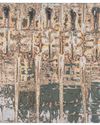
On 29 March 1987, the 63rd day of his peace march from Bombay to Amritsar’s Golden Temple, film star Sunil Dutt woke up dizzy, nauseous and with a high fever. But there was no time to lose. Dutt and fellow marchers had to reach the shrine on 13 April, Baishaki day. And Amritsar was still more than 300 kilometers away.
Wrapped in a shawl, walking stick in hand, Dutt forced himself to resume the march. Three hours later, however, he stopped at a clinic in Karnal for blood tests. The diagnosis was jaundice. Dutt’s physician, Satish Puri, flew in from Bombay and pleaded with the star to give up his venture. Although Dutt refused, he did agree to go on a special diet and rest more frequently. Thankfully, his fever subsided three days later, and on Baishaki, watched by a crowd of 35,000, Dutt and his 80 pilgrims entered the Golden Temple and worshiped at the holiest of Sikh shrines.
The 78-day, 2,500-km ordeal was Dutt’s attempt to focus India’s attention on Punjab’s turmoil. For years, he had agonized over the blood-letting, and when the terrorists murdered a handicapped girl, he could bear it no more. “We must arouse our people,” Dutt told family and friends. “Let’s march to the Golden Temple and show that we are one nation.”
The police warned Dutt he could be the terrorist’s target, but he refused to even wear a bulletproof vest. And as the group marched through seven states, public response was heartwarming. Motorists stopped to wish him luck. Thousands of barefoot villagers walked long distances to catch a glimpse of him. Dutt held nearly 500 roadside meetings and kept reiterating his theme: “Violence will not solve our problems.”
This story is from the {{IssueName}} edition of {{MagazineName}}.
Start your 7-day Magzter GOLD free trial to access thousands of curated premium stories, and 9,000+ magazines and newspapers.
Already a subscriber ? Sign In
This story is from the {{IssueName}} edition of {{MagazineName}}.
Start your 7-day Magzter GOLD free trial to access thousands of curated premium stories, and 9,000+ magazines and newspapers.
Already a subscriber? Sign In

Demonstrators by Krishna Reddy
1968 Multicolour viscosity, Print on paper

Notes from Grief Camp
Every summer, more than a hundred children come together to spend a weekend swimming, climbing and canoeing. They also learn to deal with death

Six Places Cheese Lovers Should Visit
Ancient caves, monasteries, and other must-sees for fromage fans

THE LAND OF SUPERCEN TENARIANS
A remote region of Azerbaijan claims to have many extremely long-lived residents. What is their secret, or is it just a myth?

The Whistle Blowers
My grandparents had a distinctive way of communicating

"THE NEXT AIRCRAFT WILL CRASH ON LANDING"
THE JET WAS ALMOST OUT OF FUEL. THE PILOTS' ONLY OPTION WAS A MANOEUVRE NO ONE HAD EVER ATTEMPTED.

The Secrets in our Genes
Genomic sequencing tests can reveal much about your unique physiology. But are they worth it?

GOOD NEWS FROM AROUND THE WORLD
MENTAL HEALTH When her son was arrested last year, Tambudzai Tembo's mind went to dark thoughts of suicide.

Into the Inferno
A gas station owner has seconds to react when a car crashes into a gas pump

THE CLIMATE CHANGERS
THESE PLACES ARE LEADING THE WAY TO A FUTURE FREE OF FOSSIL FUELS